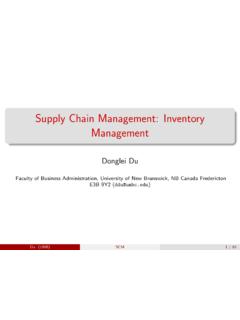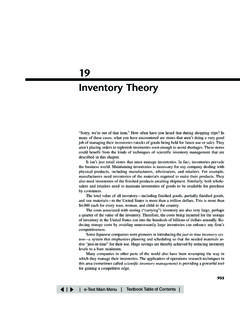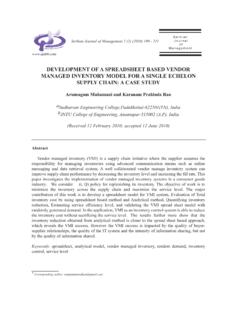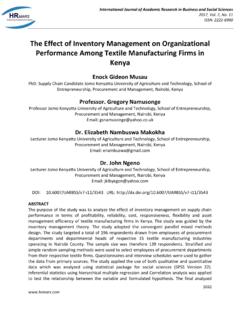Transcription of An Inventory-Location Model: Formulation, Solution ...
1 An Inventory-Location model : formulation , Solution algorithm and computational Results Mark S. Daskin Collette R. Coullard Department of Industrial Engineering and Management Sciences Northwestern University Evanston, IL 60208. Z. J. Max Shen Department of Industrial Engineering 303 Weil Hall Box 116595. University of Florida Gainesville, FL 32611-6595. February, 2001. Acknowledgements: This work was supported by NSF grants DMI-9634750 and DMI- 9812915. This support is gratefully acknowledged. Daskin, Coullard and Shen 1 03/18/01. ABSTRACT. We introduce a new distribution center (DC) location model that incorporates working inventory and safety stock inventory costs at the distribution centers. In addition, the model incorporates transport costs from the suppliers to the DCs that explicitly reflect economies of scale through the use of a fixed cost term. The model is formulated as a non-linear integer-programming problem. model properties are outlined.
2 A Lagrangian relaxation Solution algorithm is proposed. By exploiting the structure of the problem we can find a low-order polynomial algorithm for the non-linear integer programming problem that must be solved in solving the Lagrangian relaxation subproblems. A number of heuristics are outlined for finding good feasible solutions . In addition, we describe two variable forcing rules that prove to be very effective at forcing candidate sites into and out of the Solution . The algorithms are tested on problems with 88 and 150 retailers. Computation times are consistently below one minute and compare favorably with those of an earlier proposed set partitioning approach for this model (Shen, 2000; Shen, Coullard and Daskin, 2000). Finally, we discuss the sensitivity of the results to changes in key parameters including the fixed cost of placing orders. Significant reductions in these costs might be expected from e-commerce technologies.
3 The model suggests that as these costs decrease it is optimal to locate additional facilities. Daskin, Coullard and Shen 2 03/18/01. 1. Introduction Managing inventory has become a major challenge for firms as they simultaneously try to reduce costs and improve customer service in today's increasingly competitive business environment. Managing inventory consist of two critical tasks. First, we must determine the number of stocking locations or distribution centers to have. Second, we must determine the amount of inventory to maintain at each of the centers. Often these tasks are undertaken separately, resulting in a degree of suboptimization. In this paper, we outline an integrated approach to determining the number of distribution centers to establish and the magnitude of inventory to maintain at each center. We argue that the importance of inventory management as outlined above has, if anything, been heightened by e-commerce. Whether it is business to consumer (B2C) or business to business (B2B), e-commerce end customers expect high levels of service and speedy deliveries.
4 At the same time, many of the inputs to traditional inventory management decision-making are changing rapidly. E-commerce offers the hope of significantly reducing order costs thereby allowing smaller more frequent shipments. The model we propose below explicitly includes order shipment costs. As a result it is capable of estimating the impacts of sharply reduced ordering costs on the number of distributions centers, their locations , and the optimal inventory ordering policy. E- commerce can also reduce variability across the supply chain by making end customer orders visible throughout the chain. This visibility should reduce the bullwhip effect (Lee, Padmanabhan and Whang, 1997; Lee, 1996; Simchi-Levi, Kaminsky and Simchi- Levi, 2000). Our model does not directly account for these effects of e-commerce though the model does explicitly consider safety stock inventories at the distribution centers which are a function of the variability of customer demand.
5 This work was motivated by a study at a local blood bank conducted by two of the authors. The blood bank supplied roughly 30 hospitals in the greater Chicago area. Our focus was on the production and distribution of platelets, the most expensive and most perishable of all blood products. If a unit of platelets is not used within 5 days of the time it is produced from whole blood, it must be destroyed. The demand for platelets is highly variable as they are needed in only a limited number of medical contexts. When they are Daskin, Coullard and Shen 3 03/18/01. used, however, multiple units are often needed. The hospitals supplied by the blood bank collectively owned the blood bank and set prices. As a result they could return a unit of platelets up to the time it outdated and not be charged for it. Thus, there was little incentive to manage inventories in an efficient manner. Many of the larger hospitals ordered almost twice the number of platelet units that they used each year resulting in the need to destroy thousands of units of this expensive blood product.
6 Other hospitals ordered almost all of their needed platelets on a STAT or emergency basis. The blood bank often had to ship the units to these hospitals using a taxi or express courier at significant expense to the system. Clearly an improved system was needed. We proposed a revision to their pricing policies along with a system in which selected hospitals would maintain an inventory of platelets for use in neighboring hospitals. This would allow the system to take advantage of the risk-pooling effect. We selected the hospitals at which inventory would be maintained using a P-median model (Hakimi, 1963, 1964; Daskin, 1995). The model did not account directly for the working inventory or safety stock (risk-pooling) effects, for the transport costs from the blood bank to the selected hospitals or the fixed costs of establishing the facilities. Clearly, this was only a first-cut approach. The research outlined below is aimed, in part, at developing a more comprehensive and more accurate model of such a situation.
7 The remainder of this paper is organized as follows. In section 2 we review relevant related literature. The model we propose is formulated in section 3. The formulation we obtain is a mixed integer non-linear programming problem which can be viewed as an extension of the traditional uncapacitated fixed charge facility location problem. In addition to the standard facility location and local distribution costs, the model includes cost components representing working and safety stock inventories at the distribution centers as well as transport costs from the supplier(s) to the distribution centers. These inventory and supplier-to-DC transport costs introduce significant non- linearities into the model . Section 4 outlines a number of key properties of the model we propose and introduces an additional assumption on the demand distributions that we use to develop a Solution algorithm for the problem. Section 5 outlines our Solution procedure for the problem.
8 computational results are presented in section 6. In section 7, we present our conclusions and outline directions for future work. Daskin, Coullard and Shen 4 03/18/01. 2. Literature Review inventory theory literature tends to focus on finding optimal inventory replenishment strategies at the DCs and the retailer outlets. This work usually assumes that the number and locations of the DCs are given. See, for example, Graves et al. (1993), Nahmias (1997) and Zipkin (1997). On the other hand, location theory tends to focus on developing models for determining the number of DCs and their locations , as well as the DC-retailer assignments. This work usually includes fixed facility setup costs and transportation costs, but the operational inventory and shortage costs are typically ignored. Daskin and Owen (1999) provide an overview of facility location modeling as do the recent texts by Daskin (1995) and Drezner (1995). Eppen (1979) studied the so-called risk pooling effects, namely the effects of inventory -cost savings achieved by grouping retailers.
9 Assume customer demands are normally distributed with a mean i and a standard deviation i for customer i. Then the n expected total inventory cost under the decentralized mode for n retailers is K i . If i =1. the demands of the n retailers are independent, the optimal cost under a centralized mode n n can be expressed by K i2 , which is less than K i , where K is a constant i =1 i =1. depending on the holding and penalty costs and the standard normal loss function. Recently, there are several new studies that combine inventory management and routing decisions. For example, Federgruen and Zipkin (1984), Federgruen and Simchi- Levi (1995), Viswanathan and Mathur (1997), Chan, Federgruen, and Simchi-Levi(1998). and Kleywegt, Nori, and Savelsbergh (2000). Also, several models combine location and routing decisions; for instance, Laporte and Dejax (1989), Berman, Jaillet and Simchi-Levi (1995), and Berger, Coullard and Daskin (1998).
10 Shen, Coullard and Daskin (2000) studied model presented below, but they use set partitioning approach. We compared our computational results with theirs. Teo, Ou Daskin, Coullard and Shen 5 03/18/01. and Goh (2000) studied the impact on inventory costs with consolidation of distribution centers. They also propose an algorithm that solves for a distribution system with the total fixed facility location cost and inventory costs within 2 of the optimal. But they ignore the costs to ship from the supplier to the DCs and from the DCs to the retailers in their model . Finally, Erlebacher and Meller (2000) formulate a highly non-linear integer location/ inventory model . They attack the problem by using a continuous approximation as well as a number of construction and bounding heuristics. For problems with 16. customers, they obtained solutions that were between and nearly 36% of a lower bound. An exchange heuristic improved the Solution considerably.












